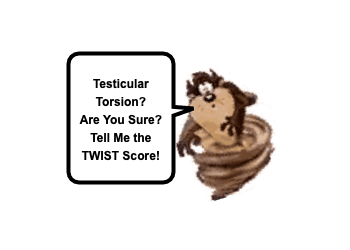Originally published at Pediatric EM Morsels on January 4, 2019. Reposted with permission.
Follow Dr. Sean M. Fox on twitter @PedEMMorsels
A New Year begins. With it, personal resolutions are being made throughout the lands. If you have yet to select a worthwhile New Year’s Resolution, join me in striving toward an improvement goal that can benefit ourselves as well as may actually help others. What’s this noble goal? Unambiguous Commincation. Certainly, this is a skill we all can improve and one that has direct, and sometimes dire, consequences in our professional lives. One of the most vital attributes of clear communication is ensuring that you are speaking the same “language” as the other party. This is intuitive, but on occasion we underestimate its importance. Certainly, I need an interpreter for patients who don’t speak my language (sometimes I even need help with the English language), but let’s not overlook the various languages our other medical specialist and colleagues use. Medical languages have many dialects and regional variances. When we speak to our Orthopods, we should know what terms are meaningful to them when describing a Supracondular fracture. Recently, I learned a new phrase that can help me clearly communicate with our Urology colleagues when dealing with children presenting with acute scrotal pain. Let’s make sure we speak clearly – Testicular Workup for Ischemic and Suspected Torsion (TWIST):
Testicular Torsion: Basics
- Testicular Torsion has 2 peaks of incidence: one peak during 1st year of life and another from 12-18 yrs.
- Classic presentation is of:
- Acute, unilateral testicular pain with,
- Nausea and vomiting
- Absent cremasteric reflex on affected side
- Swelling and tenderness
- Abnormal testicular position
- Unfortunately, nothing is that simple, and classic is not common.
- Cases of testicular torsion have occurred in which each finding has been violated, including having had torsion in the presence of normal cremasteric reflexes.
- Intermittent Torsion (Torsion – Detorsion) does occur –
- Can lead to confounding presentations and even “fool” ultrasound.
- 50% of patients diagnosed with torsion have had a prior episode of intermittent torsion that had spontaneous resolution.
- Time is critical though (as with it with many of the conditions we mange in the ED).
- Salvage rates are very good for Torsion lasting <6 hours (90-100%) [Frohlich, 2017]
- Rates are not as good between 6-12 hours (20-50%) and …
- Very low after 12 hours (<11%) [Frohlich, 2017]
- Waiting for imaging can lead to further delay.
- Salvage rates are very good for Torsion lasting <6 hours (90-100%) [Frohlich, 2017]
Testicular Torsion: The Dilemma
- There are several factors in this equation:
- Time is critical.
- Testicular torsion is less common than other causes of acute scrotal pain.
- Urologist do not usually hang out in the ED waiting for boys with testicular pain to show up.
- No single historic or exam feature can reliably rule in or rule out the condition.
- Ultrasound is often requested to further assist with clarity.
- Ultrasound takes time (although, another great reason to improve your use of bedside ultrasound – that can be another New Year’s Resolution).
- A possible way to improve clarity of communication has recently been advocated for – The TWIST Score
Testicular Torsion: TWIST Score
- Testicular Workup for Ischemic and Suspected Torsion (TWIST) Score was developed by Urologist, validated with non-physician triage, and recently tested in tertiary Pediatric ED with physician providers utilizing it. [Frohlich, 2017; Sheth, 2016; Brunhara, 2016]
- TWIST Score is a Summation of 5 Clinical Variable:
- Presence of Testicular Swelling = 2 points
- Presence of Hard Testicle = 2 points
- Absence of Cremasteric Reflex = 1 point
- Presence of High Riding Testicle = 1 point
- Presence of Nausea/Vomiting = 1 point
- Scores, Risk, and Proposed Management [Frohlich, 2017; Sheth, 2016; Brunhara, 2016]
- High Risk = Score of 6 or 7
- NO imaging.
- Consider imaging those children who are Tanner Stage 1-2 (who had more confounded exams) – some advocate for only using TWIST Score in pubertal males.
- Convey this high risk score and help expedite surgical exploration with your Urology colleagues.
- Intermediate Risk = Scores of 1-5
- Obtain scrotal ultrasound
- Consider alternative diagnoses (ex, Epididymitis) and obtain additional testing as warranted (ex, U/A, STD screen)
- “Low” Risk = Scores of 0
- In original paper, “Low Risk” was not associated with Torsion and avoiding ultrasound in this group was advocated for…. but, as was mentioned above, Torsion can be deceptive and present atypically… so I would still have a low threshold for obtaining an ultrasound.
- Alternative diagnosis is more likely, though, so consider the rest of the DDx as well (ex, Epididymitis, Varicoceles, UTI, Nephrolithiasis, Mumps, HSP).
- High Risk = Score of 6 or 7
Moral of the Morsel
- Communication is a 2 Way Street. Make sure we are speaking the right language.
- Don’t Get it TWISTed! Know the TWIST Score and communicate it clearly to your Urology colleagues, but know that it is not perfect and your H+P and clinical acumen need to be “calculated” as well.
- Coordinate with your Urology Colleagues Early. For time sensitive conditions, particularly ones that may lead to early activation of an OR, develop strategies and protocols even before the patient has arrived!








